How Many Registered Independant In The United States
Independents often are portrayed as political free agents with the potential to alleviate the nation'southward rigid partisan divisions. Still the reality is that most independents are not all that "independent" politically. And the small share of Americans who are truly contained – less than ten% of the public has no partisan leaning – stand out for their low level of interest in politics.
Amid the public overall, 38% depict themselves as independents, while 31% are Democrats and 26% phone call themselves Republicans, according to Pew Research Center surveys conducted in 2018. These shares have changed only modestly in recent years, simply the proportion of independents is higher than it was from 2000-2008, when no more than about a tertiary of the public identified as independents. (For more on partisan identification over time, see the 2018 report "Broad Gender Gap, Growing Educational Split up in Voters' Party Identification.")
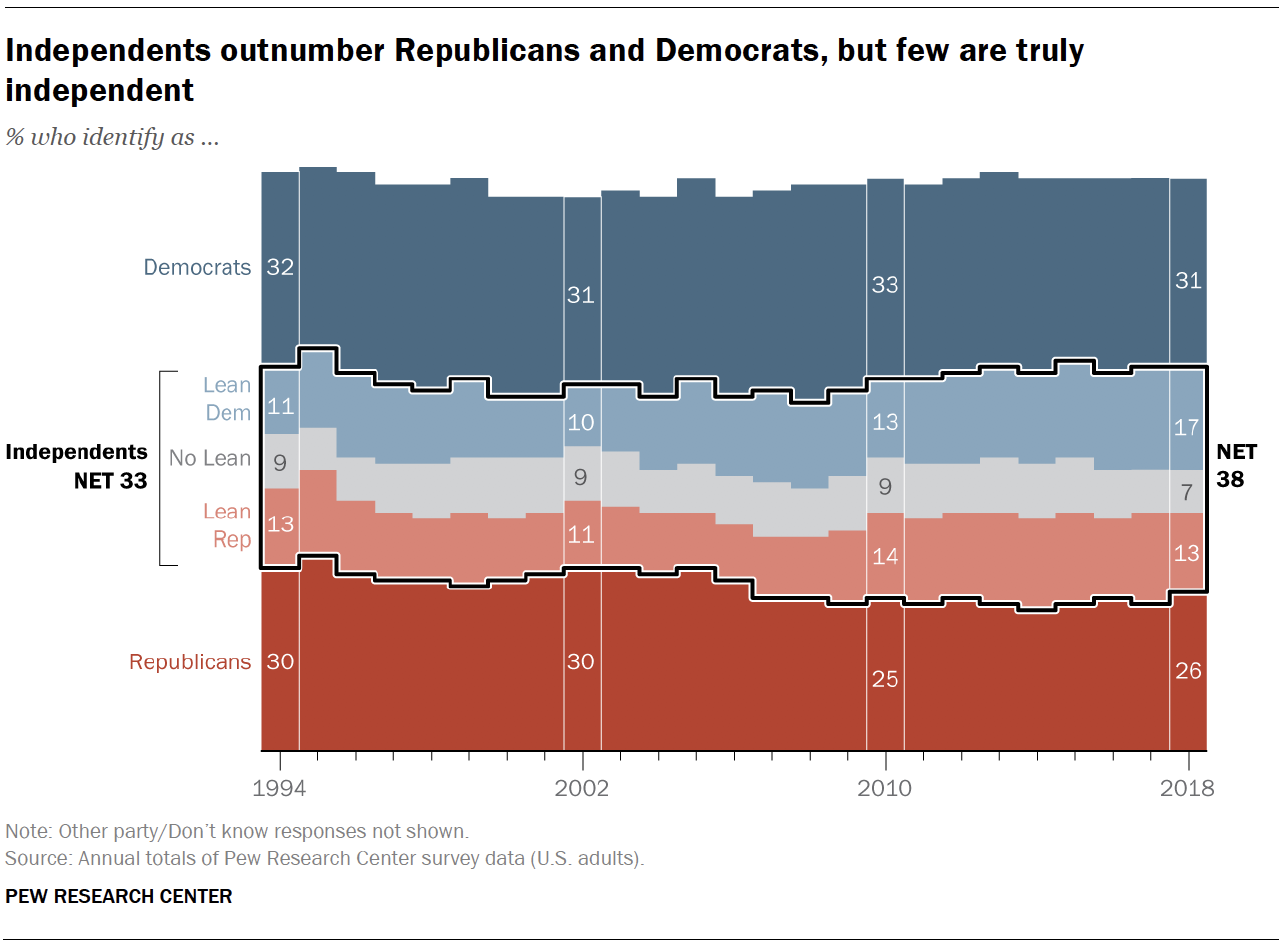
An overwhelming bulk of independents (81%) proceed to "lean" toward either the Republican Political party or the Democratic Party. Among the public overall, 17% are Democratic-leaning independents, while thirteen% lean toward the Republican Political party. Just 7% of Americans decline to lean toward a political party, a share that has inverse little in contempo years. This is a long-continuing dynamic that has been the subject of past analyses, both by Pew Research Center and others.
In their political attitudes and views of virtually issues, independents who lean toward a party are in general agreement with those who chapter with the same party. For example, Republican-leaning independents are less supportive of Donald Trump than are Republican identifiers. Nevertheless, nigh seventy% of GOP leaners approved of his job performance during his first two years in office. Autonomous leaners, like Democrats, overwhelmingly disapprove of the president.
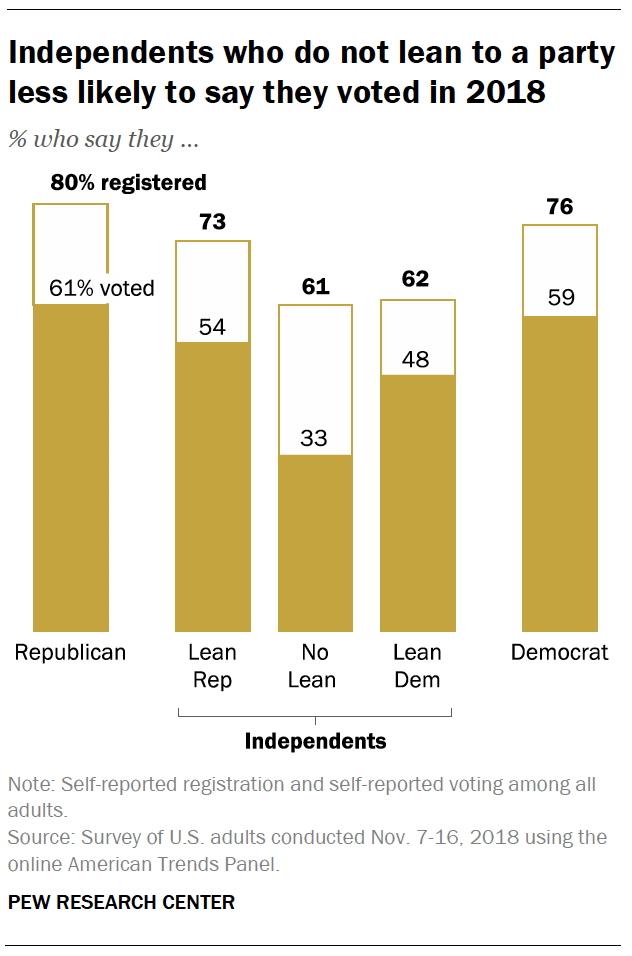 At that place are some issues on which partisan leaners – especially those who lean toward the GOP – differ substantially from partisans. While a narrow majority of Republicans (54%) opposed aforementioned-sex-union in 2017, about six-in-x Republican-leaning independents (58%) favored allowing gays and lesbians to ally legally.
At that place are some issues on which partisan leaners – especially those who lean toward the GOP – differ substantially from partisans. While a narrow majority of Republicans (54%) opposed aforementioned-sex-union in 2017, about six-in-x Republican-leaning independents (58%) favored allowing gays and lesbians to ally legally.
Yet independents who lean toward one of the ii parties take a strong partisan imprint. Majorities of Republican and Democratic leaners accept a favorable opinion of their own party, and they are almost every bit probable every bit Republican and Democratic identifiers to have an unfavorable stance of the opposing party.
Independents stand out from partisans in several important ways. They are less politically engaged than Republicans or Democrats – and this is especially the case amid independents who practise not lean to a party.
In a survey conducted last fall, before long later on the midterm elections, partisan leaners were less likely than partisans to say they registered to vote and voted in the congressional elections. About half of Democratic-leaning independents (48%) said they voted, compared with 59% of Democrats. The differences were comparable betwixt GOP leaners (54% said they voted) and Republicans (61%).
Those who do not lean toward a party – a group that consistently expresses less interest in politics than partisan leaners – were less likely to say they had registered to vote and much less likely to say they voted. In fact, just a third said they voted in the midterms.
In addition, independents differ demographically from partisans. Men constitute a bulk (56%) of independents. That is higher than the share of men amid Republican identifiers (51% are men) and much higher than the share of men among Democrats (only forty%).
Among independents, men make up a sizable share (64%) of Republican leaners and a smaller majority (55%) of independents who practise not lean. Autonomous leaners include roughly equal shares of men (51%) and women (49%).
Independents besides are younger on average than are partisans. Fewer than one-half of independents (37%) are ages 50 and older; amid those who identify as Democrats, 48% are 50 and older, as are a majority (54%) of those who identify as Republicans.
Autonomous-leaning independents are younger than other independents or partisans. About a third (31%) are younger than 30, compared with 21% of Republican-leaning independents and just 19% and 14%, respectively, amid those who place equally Democrats and Republicans.
Trump divides partisans and partisan leaners alike
Equally Pew Inquiry Middle reported concluding year, Donald Trump's task approval rating during the early stage of his presidency is more polarized along partisan lines than whatever president in the past six decades. In addition, Trump'southward rating has been more stable than prior presidents.
During his starting time two years in role, Trump's job rating among members of his own party was relatively high compared with contempo presidents. In 2017, 85% of those who place as Republicans approved of Trump's job performance, based on an average of Pew Research Center surveys. His job rating among Republicans was about as high (84%) in 2018. Trump'southward early job rating among members of the opposing party (7%) was much lower than those of 3 prior presidents (Barack Obama, George W. Bush and Bill Clinton).
Trump's job rating among independents for his first ii years in function likewise was lower than his recent predecessors; his average task rating among independents was 34% in both 2017 and 2018. Obama's average rating was 50% during his starting time year (2009); information technology barbarous to 42% in his second year.
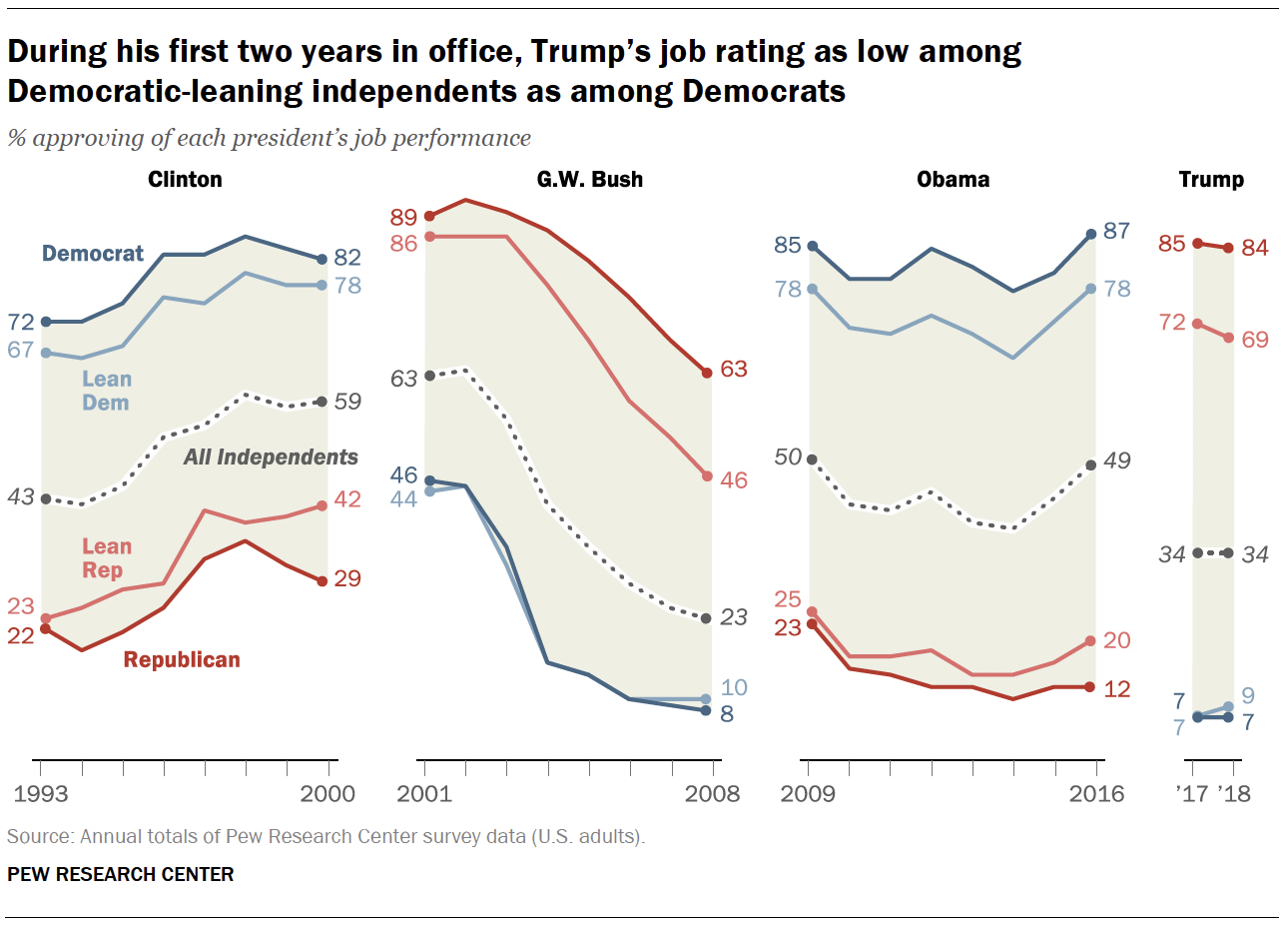
Trump's early rating amongst independents is closest to Clinton's, whose job approval averaged near 42% during his start 2 years in office. Bush, whose overall job rating approached 90% in his showtime yr following the 9/xi terrorist attacks, had approval ratings above 60% among independents in his kickoff two years.
Trump's job rating amongst independents, similar his overall rating, breaks down along partisan lines. His rating amongst GOP-leaning independents (72% in 2017, 69% in 2018) was not markedly dissimilar from Obama'southward and Clinton'south ratings among Democratic-leaning independents during their get-go two years in function (though much lower than Bush'southward among Republican leaners).
Yet Trump's rating amid independents who lean to the opposing party – similar his rating among members of the opposing party – was much lower than recent presidents'. In fact, his rating among Democratic-leaning independents during his get-go two years was virtually equally low as his rating amidst Democrats (7% in 2017, ix% in 2018).
Trump's rating also was low amid independents who have no partisan leanings. Only about a quarter of non-leaners approved of Trump'southward job performance during his get-go two years, while virtually six-in-ten (58%) disapproved.
Independents' views of U.S.-United mexican states edge wall, other key issues
On near issues, independents' attitudes mirror the views of the overall public. Independents who lean toward a political party are usually on the same side as those who identify with the same political party, only the level of agreement between leaners and partisans varies depending on the upshot.
By a wide margin (62% to 36%), independents oppose Trump's signature policy proposal, an expansion of the U.South.-Mexico border wall. Democratic-leaning independents overwhelmingly oppose the border wall (95% disapprove), every bit do Democratic identifiers (92%).
Republican-leaning independents favor expanding the edge wall, though by a smaller margin than Republicans identifiers. GOP leaners favor essentially expanding the wall along the U.Due south.-Mexico border by roughly three-to-one (75% to 23%). Amongst those who affiliate with the Republican Party, the margin is near eight-to-i (87% to 11%).
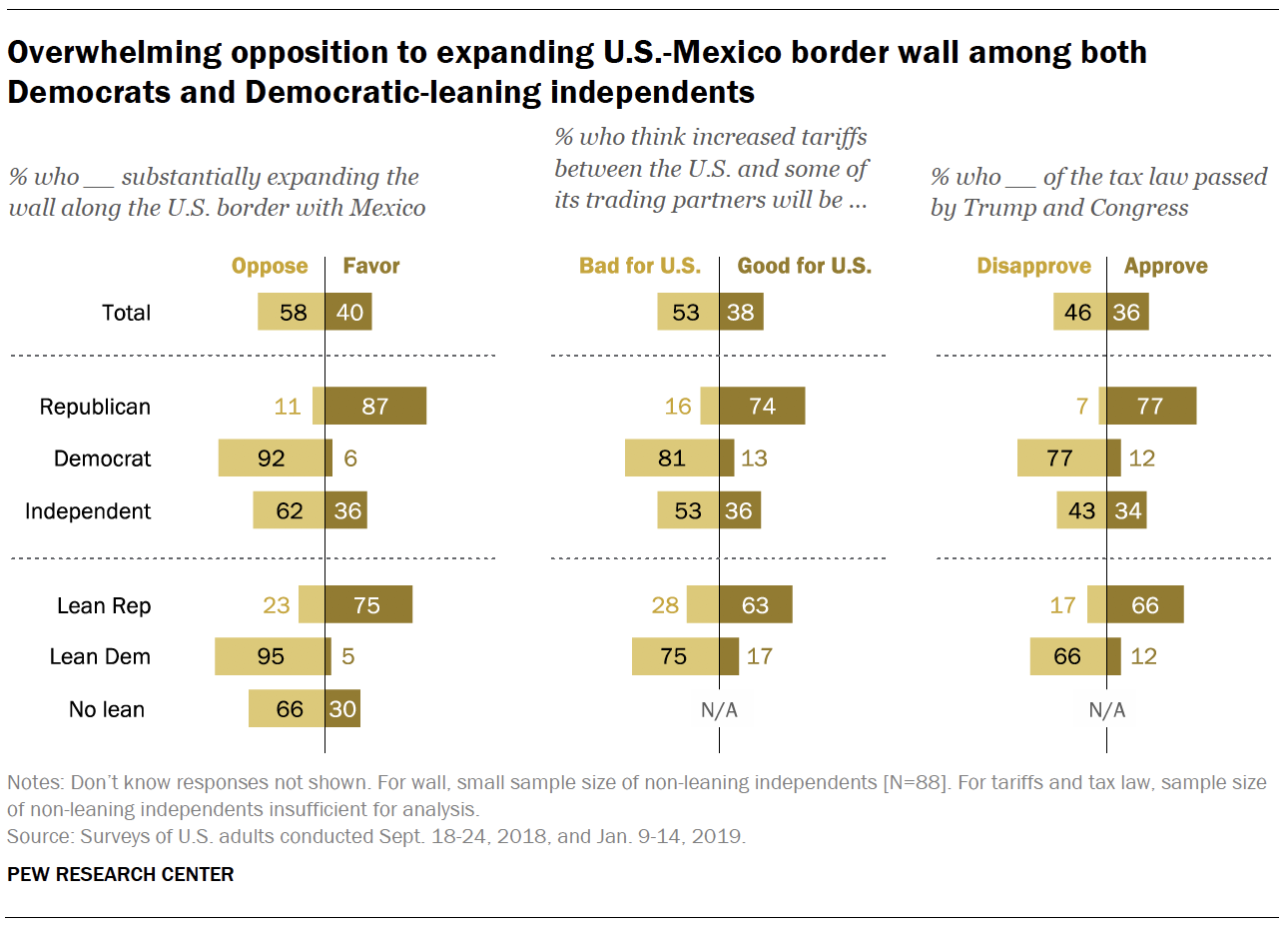
Independents besides accept a negative view of increased tariffs between the U.S. and its trading partners (53% say they will exist bad for the U.S., 36% good for the U.S.). Independents' views on the 2017 tax bill are more than divided: 34% approve of the tax law and 43% disapprove.
As with the border wall, Democratic-leaning independents are more likely to view increased tariffs negatively (75% say they will be bad for the U.S.) than Republican-leaning independents are to view them positively (66% say they will be good). On taxes, 2-thirds of GOP leaners approve of the tax law, while an identical share of Autonomous leaners disapprove.
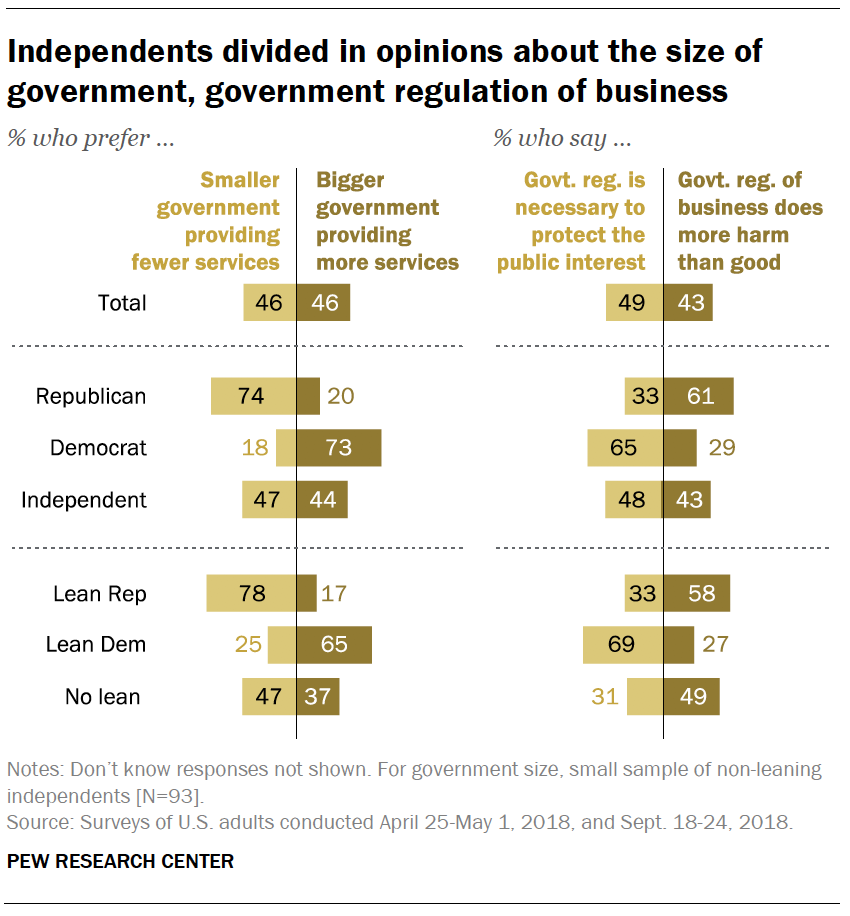 Overall, independents are divided in preferences about the size of authorities and views about government regulation of business.
Overall, independents are divided in preferences about the size of authorities and views about government regulation of business.
Republican-leaning independents largely adopt a smaller government providing fewer services; 78% favor smaller government, compared with just 17% who favor bigger authorities with more services.
The views of GOP leaners are nearly identical to the opinions of those who affiliate with the GOP (74% prefer smaller government). Like Democrats, nearly Autonomous-leaning independents prefer bigger government.
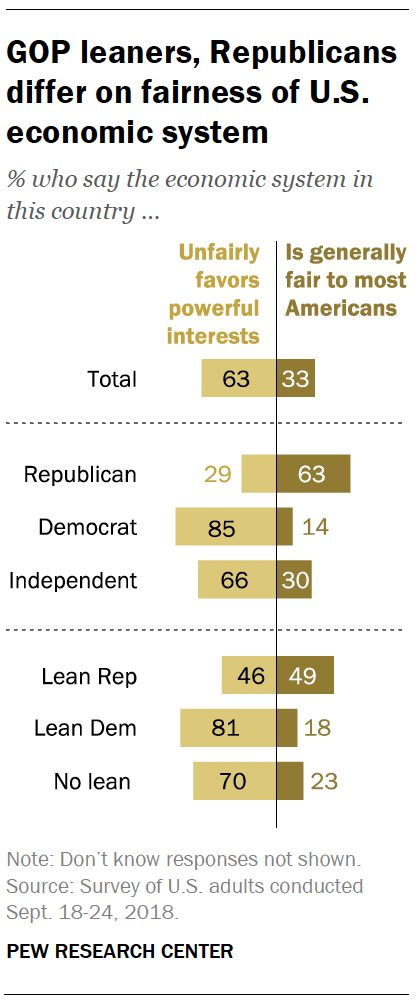 Democrats and Democratic leaners are in sync in opinions almost whether the nation's economical system is generally fair. Simply there are sharper differences in the views of Republicans and GOP leaners.
Democrats and Democratic leaners are in sync in opinions almost whether the nation's economical system is generally fair. Simply there are sharper differences in the views of Republicans and GOP leaners.
A 63% majority of those who identify equally Republicans say the U.S. economical system is fair to most Americans; fewer than half as many (29%) say the system unfairly favors powerful interests. GOP leaners are divided: 49% say the system is generally off-white, while nearly as many (46%) say it unfairly favors powerful interests.
Big majorities of both Democrats (85%) and Democratic leaners (81%) say the U.Southward. economic organisation unfairly favors powerful interests. Most independents who do not lean toward a party share this view (70%).
Independents' views of race, immigrants, gender
Majorities of independents say the U.Due south. needs to continue to make changes to give blacks equal rights with whites (57%) and that significant obstacles notwithstanding get in harder for women to get ahead (54%). In addition, far more independents say immigrants do more than to strengthen (66%) than burden (23%) the country.
In views of racial equality and women's progress, the views of partisan leaners are comparable to those of partisans. Large majorities of Democrats and Autonomous leaners say the U.Due south. needs to make more changes to give blacks equal rights and that pregnant obstacles stand in the way of women. About Republicans and Republican leaners say the country has fabricated needed changes to requite blacks equal rights with whites, and that the obstacles blocking women's progress are largely gone.
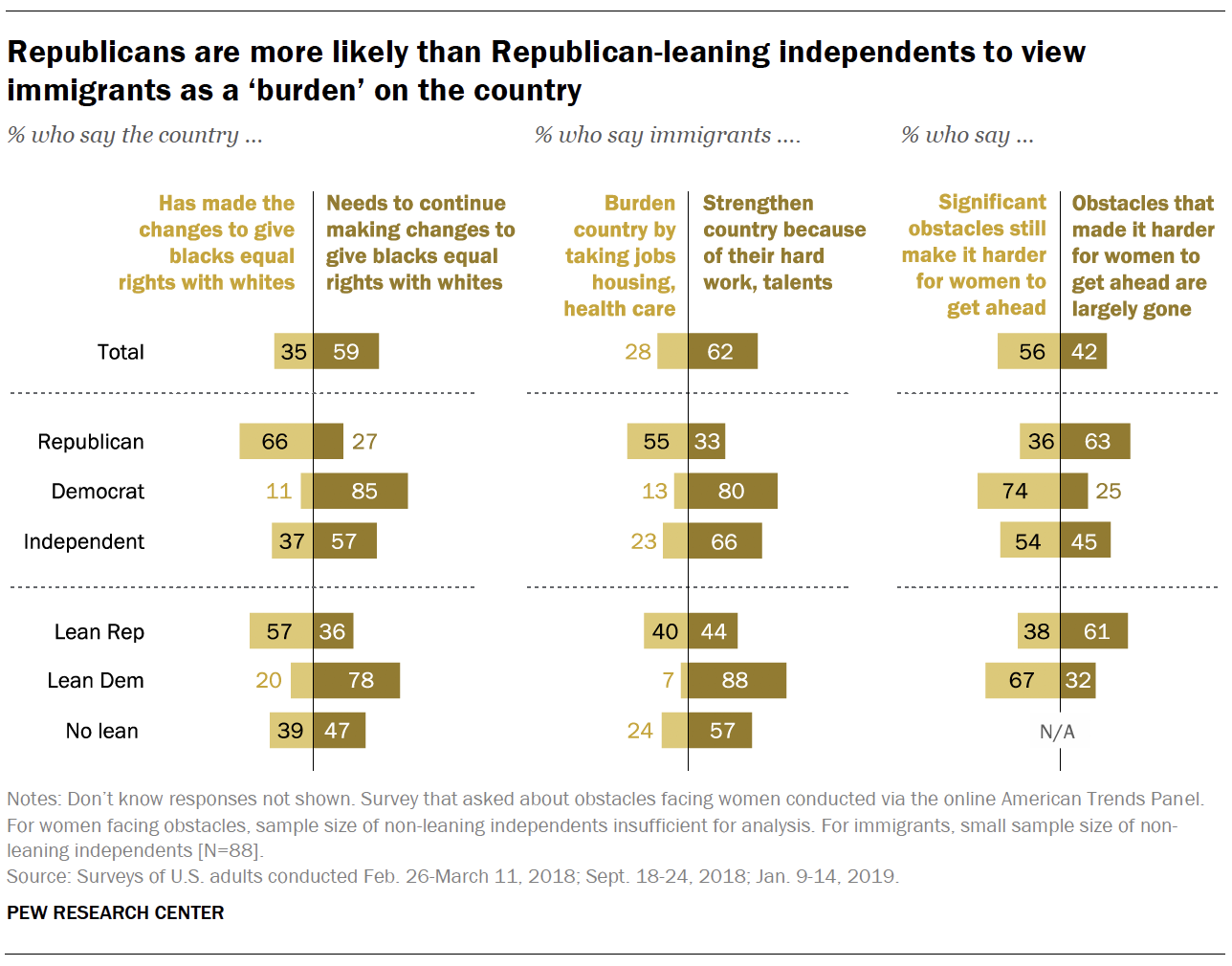
However, Republican-leaning independents differ from Republicans in their views of immigrants' impact on the country. Among GOP leaners, 44% say immigrants strengthen the country because of their hard piece of work and talents; 40% say they are a brunt on the country because they take jobs, housing and wellness care. A majority of those who place as Republicans (55%) say immigrants burden the country.
Views of immigrants' touch on the country are largely positive amongst Autonomous-leaning independents (88% say they strengthen the U.Southward.) and those who identify as Democrats (80%).
Broad support amidst independents for same-sex union, marijuana legalization
Public support for same-sex union has grown quickly over the past decade. In June 2017, a majority of adults (62%) favored assuasive gays and lesbians to marry legally, while just 32% were opposed.
Independents' views of same-sex-marriage were like to Democrats': 73% of Democrats favored gay marriage, as did 70% of independents. Among those who identified as Republicans, just 40% favored aforementioned-sex marriage, while 54% were opposed.
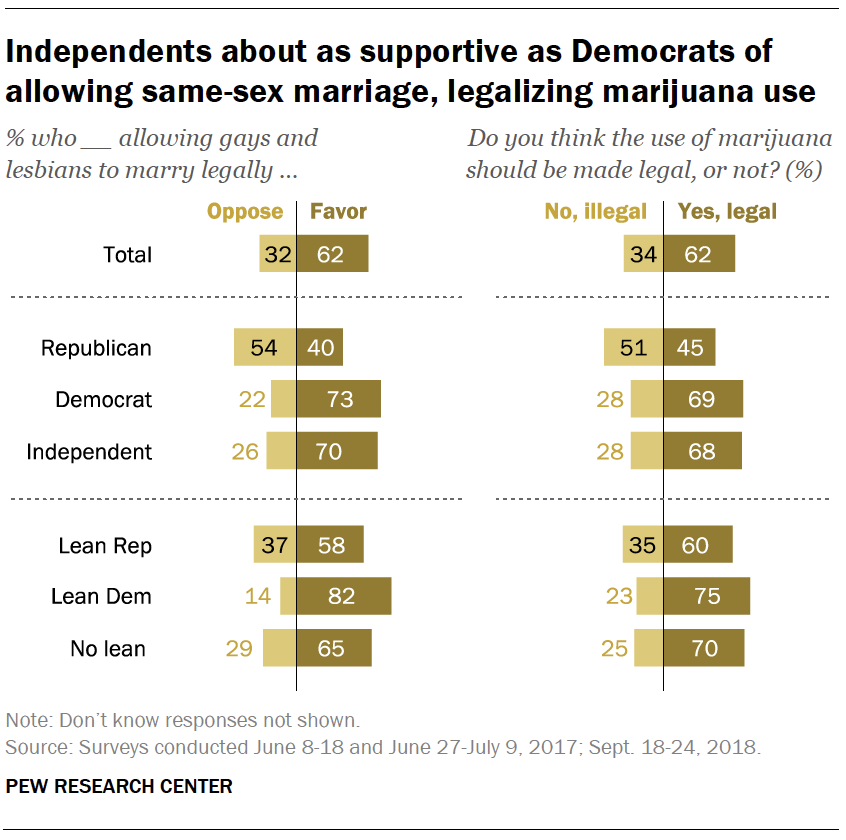 In contrast to Republicans, Republican-leaning independents favored same-sex marriage (58% were in favor, 37% were opposed). Support for same-sex marriage was higher amidst Democratic-leaning independents than amongst Democrats (82% vs. 73%).
In contrast to Republicans, Republican-leaning independents favored same-sex marriage (58% were in favor, 37% were opposed). Support for same-sex marriage was higher amidst Democratic-leaning independents than amongst Democrats (82% vs. 73%).
Public support for legalizing marijuana use has followed a similar upward trajectory in recent years. Currently, 62% of the public says the use of marijuana should be made legal, while 34% say information technology should be illegal.
Majorities of both Democrats (69%) and independents (68%) favor legalizing marijuana; Republicans are divided, with 45% supportive of legalization and 51% opposed. Among GOP-leaning independents, a 60% majority favors legalizing marijuana. And a large majority of Autonomous-leaning independents (75%) also favors marijuana legalization.
Independents who practise not lean to a party widely favored same-sex marriage (65% favor this), while lxx% say the apply of marijuana should be legal.
More than partisans and partisan leaners comprehend ideological labels
Equally in the past, more than independents describe their political views as moderate (43%) than conservative (29%) or liberal (24%). These shares have changed footling in recent years.
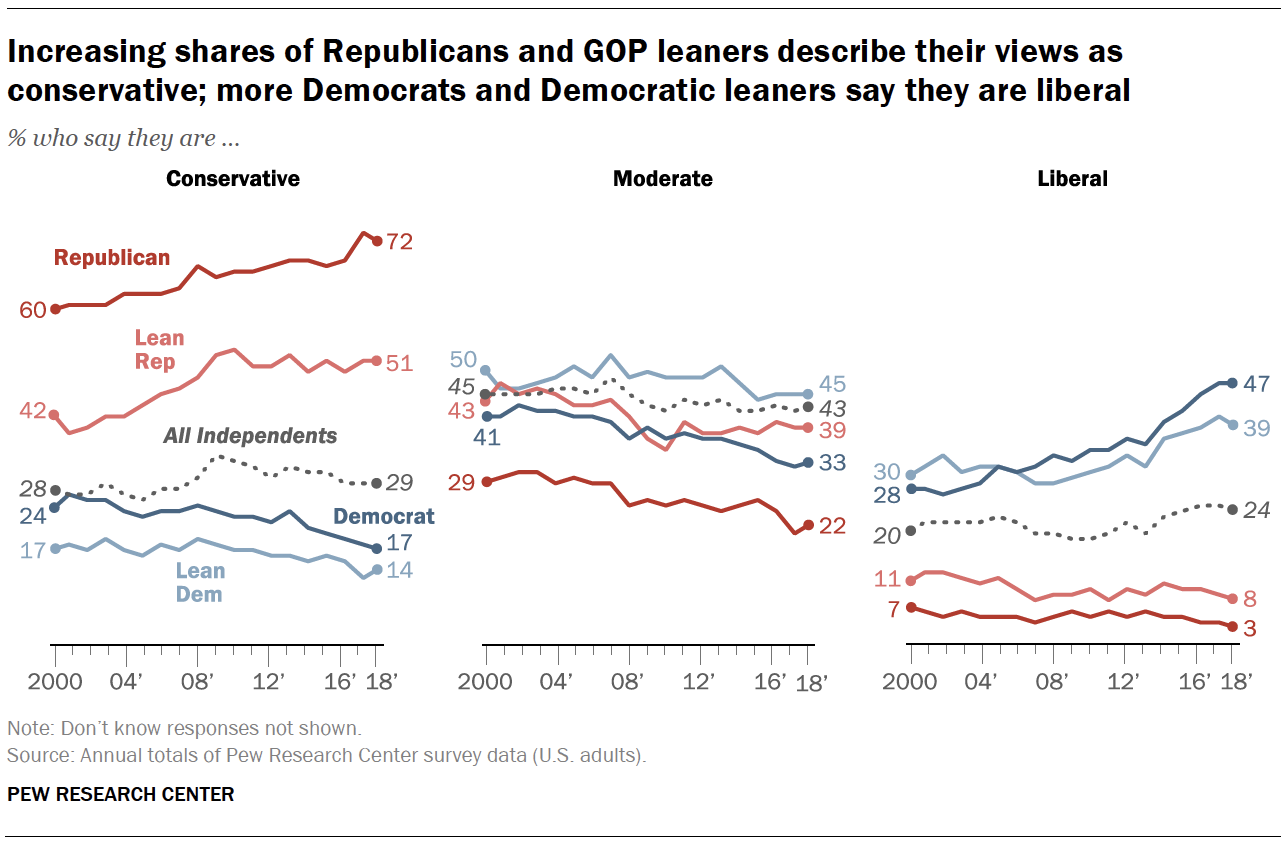
Since 2000, in that location accept been sizable increases in the shares of both Republicans and Republican-leaning independents who identify as conservative. Today, more than Republican-leaning independents depict themselves as conservatives (51%) than every bit moderates (39%) or liberals (8%). In 2000, GOP leaners included most identical shares of conservatives (42%) and moderates (43%); 11% described their views as liberal.
Over the same menstruum, there has been growth in the shares of Democrats and Democratic leaners identifying as liberal. Amongst Democratic-leaning independents, slightly more place as moderates (45%) than equally liberals (39%), while 14% are conservatives. Merely the gap has narrowed since 2000, when moderates outnumbered liberals, 50% to xxx%.
Past contrast, moderates continue to make up the largest share of independents who do not lean to a political party. Nearly half of independents who do not lean to a party describe their views every bit moderate, while 24% are conservatives and eighteen% are liberals. These numbers have changed little since 2000.
How independents view the political parties
In a two-party system, it is non surprising that most Americans view their own political party favorably while viewing the opposing political party unfavorably. Ii-thirds of Americans (66%) view ane party favorably while expressing an unfavorable opinion of the other party. About i-in-five (17%) experience unfavorably toward both parties, while 12% feel favorably toward both.
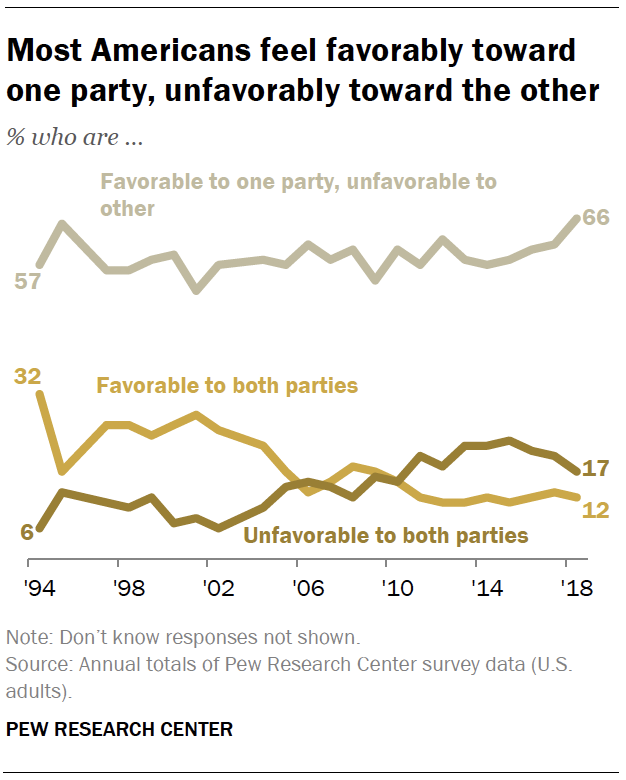 The share of Americans who take a positive view of one party and a negative view of the other has increased since 2015 (from 58%). Over the same menstruum, in that location has been a decline in the share expressing a negative view of both parties, from 23% in 2015 to 17% currently.
The share of Americans who take a positive view of one party and a negative view of the other has increased since 2015 (from 58%). Over the same menstruum, in that location has been a decline in the share expressing a negative view of both parties, from 23% in 2015 to 17% currently.
Independents who lean toward a party are less likely than partisans to view their political party favorably. In addition, far more independents (28%) than Republicans (x%) or Democrats (9%) have an unfavorable opinion of both parties.
Still, the share of independents who view both parties negatively has declined in recent years. At 1 point in 2015, more than than a 3rd of independents (36%) viewed both parties unfavorably.
Most of the change since then has come amongst Republican-leaning independents, who feel much more positively about the GOP than they did and then. In July 2015, just 44% of GOP leaners had a favorable stance of the Republican Political party; 47% had an unfavorable view of both parties. Today, a bulk of GOP leaners view the Republican Party favorably (55%), while just 24% view both parties unfavorably.
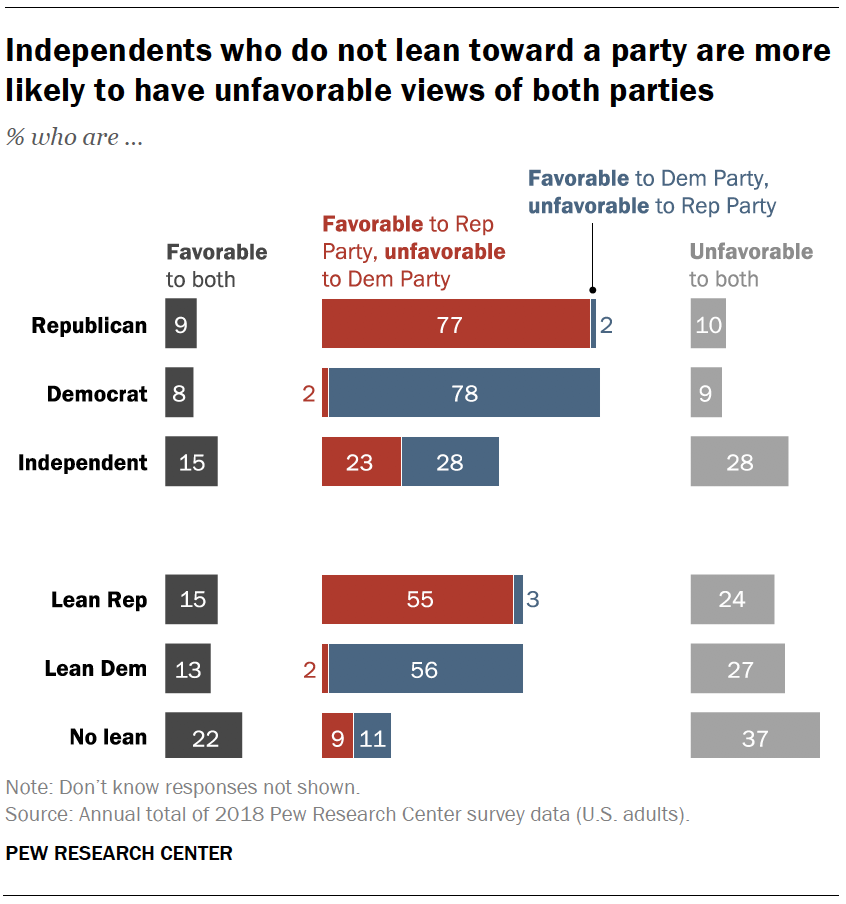 Independents who do not lean to a party are most likely to have an unfavorable opinion of both parties (37%). Another 22% have favorable opinions of both parties. Just xi% of independents who do not lean to a party view the Democratic Party favorably, while nearly as many (ix%) accept a favorable view of the GOP.
Independents who do not lean to a party are most likely to have an unfavorable opinion of both parties (37%). Another 22% have favorable opinions of both parties. Just xi% of independents who do not lean to a party view the Democratic Party favorably, while nearly as many (ix%) accept a favorable view of the GOP.
Growing partisan contempt amid partisans and leaners
Over the by 2 decades, Republicans and Democrats accept come to view the opposing party more negatively. The same trend is evident among independents who lean toward a party.
Currently, 87% of those who identify with the Republican Political party view the Democratic Political party unfavorably; Republican-leaning independents are almost as likely to view the Democratic Party negatively (81% unfavorable). Opinions among Democrats and Democratic leaners are nearly the mirror paradigm: 88% of Democrats and 84% of Democratic leaners view the GOP unfavorably. In both parties, the shares of partisan identifiers and leaners with unfavorable impressions of the opposition political party are at or near all-fourth dimension highs.
Perchance more of import, intense dislike of the opposing party, which has surged over the past ii decades amid partisans, has followed a similar trajectory among independents who lean toward the Republican and Autonomous parties.
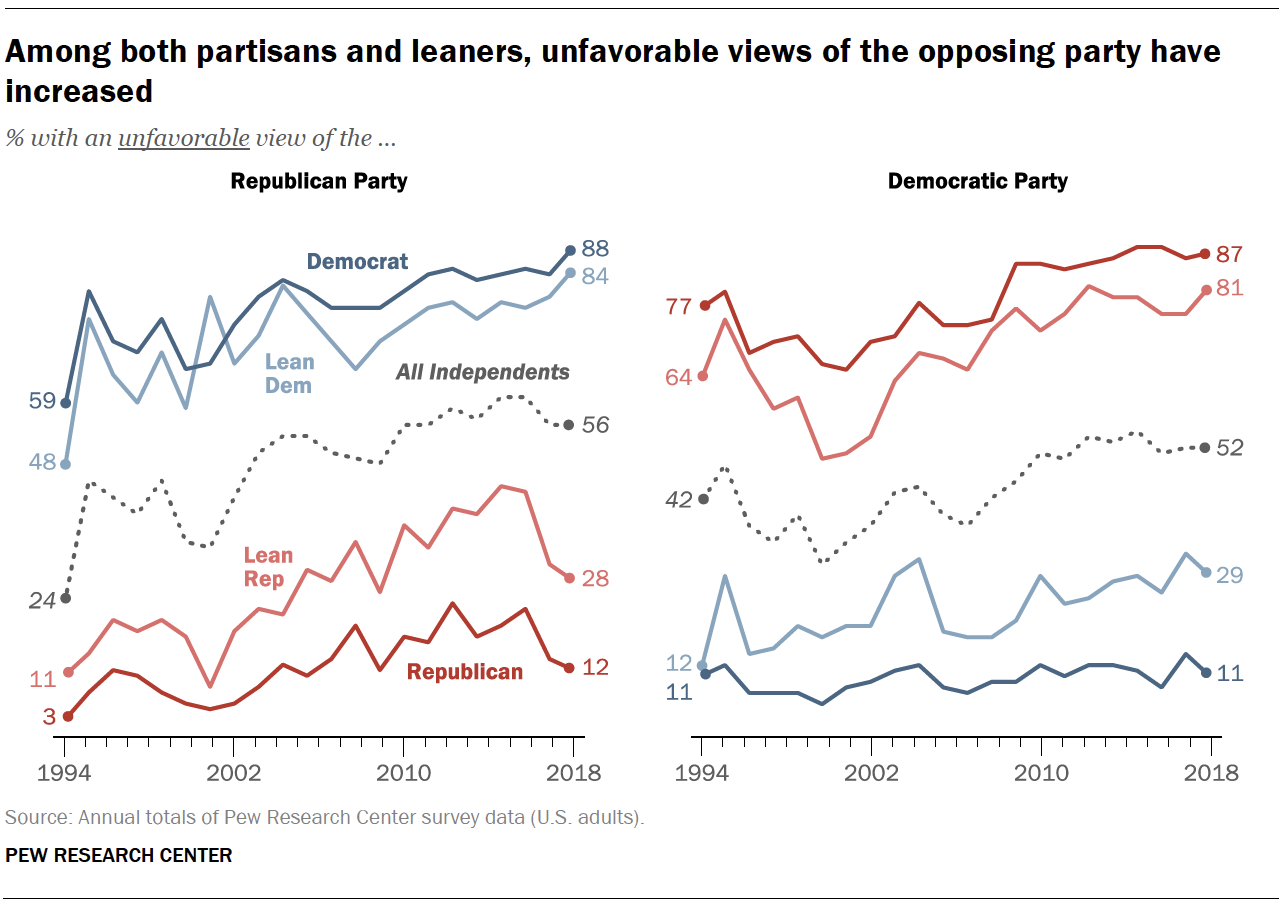
The share of Autonomous-leaning independents with a very unfavorable opinion of the Republican Party has more than quadrupled betwixt 1994 and 2018 (from viii% to 37%). There has been a similar tendency in how Republican leaners view the Democratic Party; very unfavorable opinions have increased from 15% in 1994 to 39% in 2018.
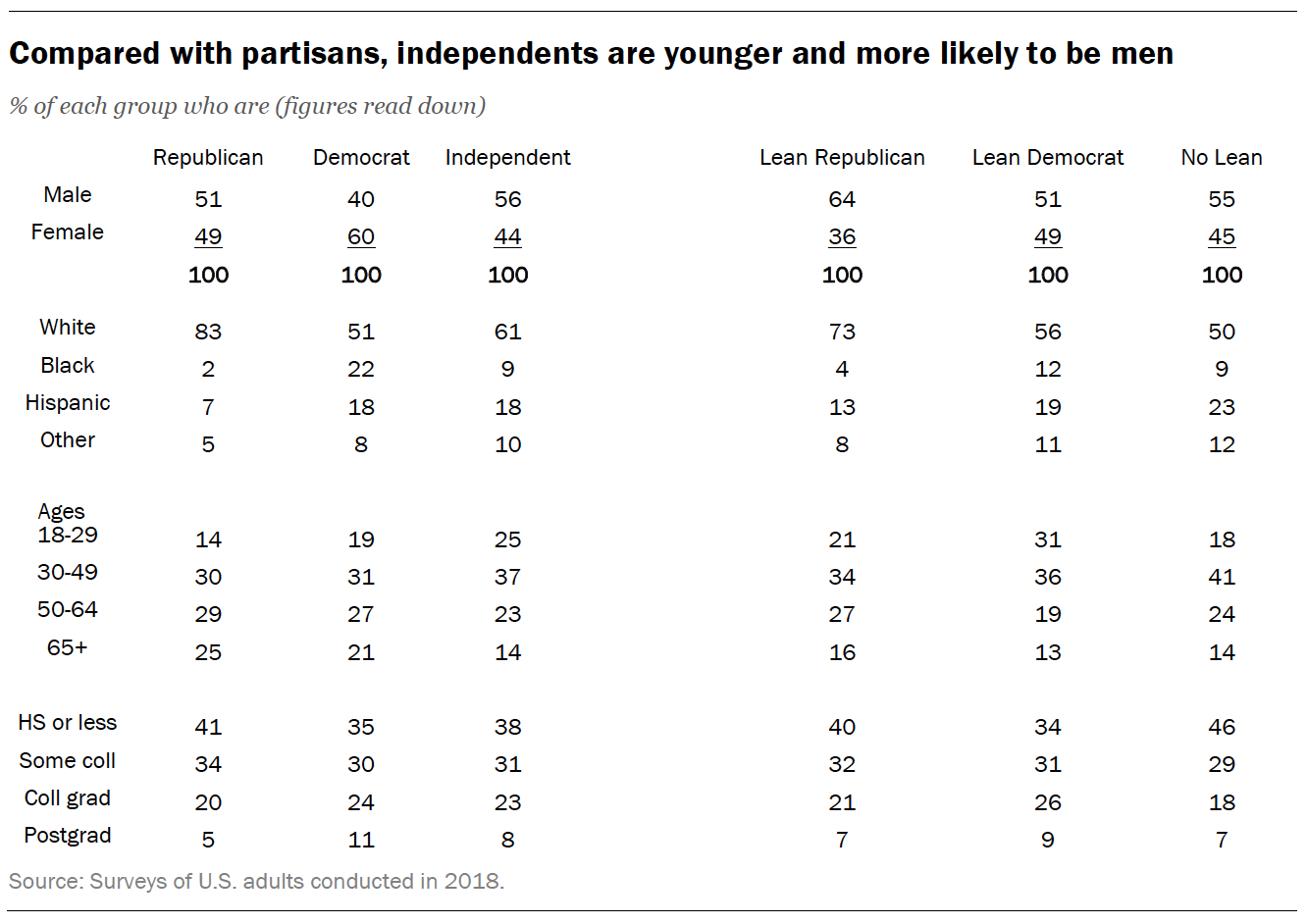
Source: https://www.pewresearch.org/politics/2019/03/14/political-independents-who-they-are-what-they-think/
Posted by: wattsagron1970.blogspot.com


0 Response to "How Many Registered Independant In The United States"
Post a Comment